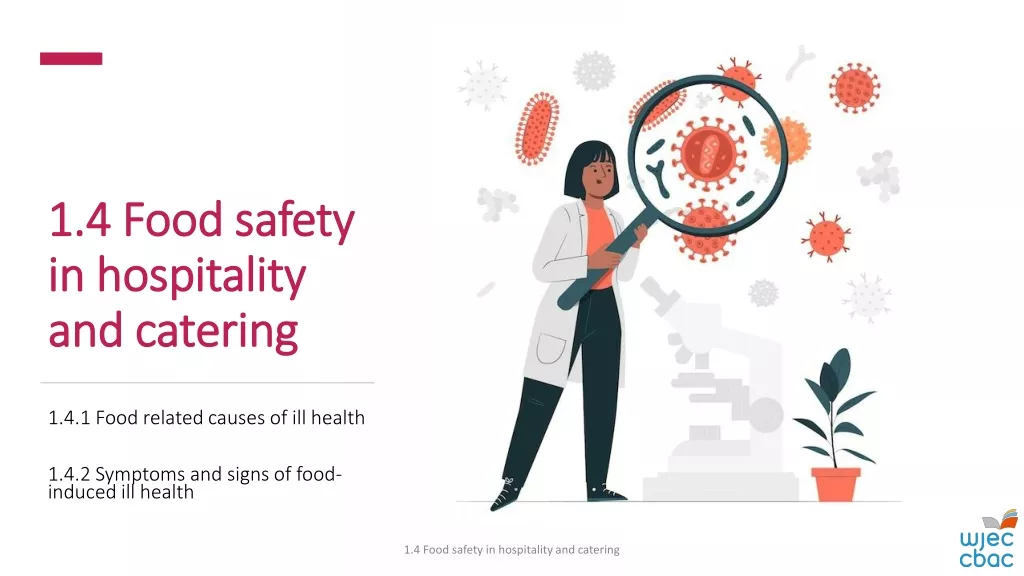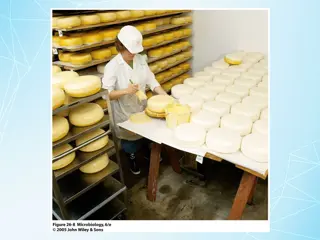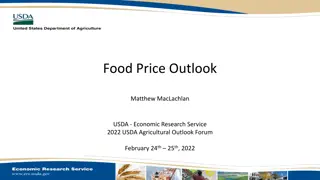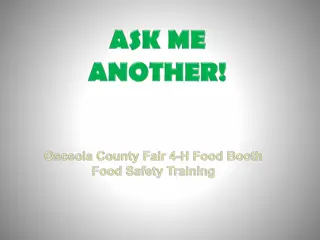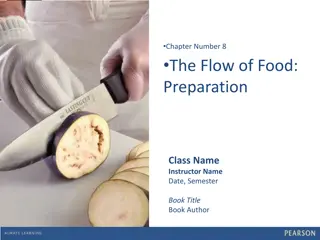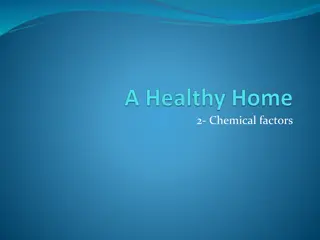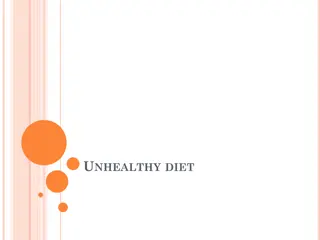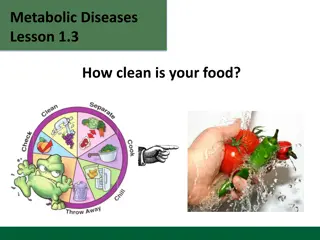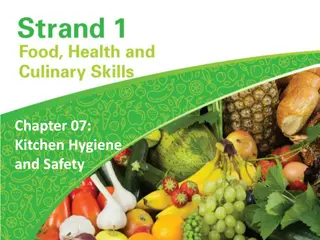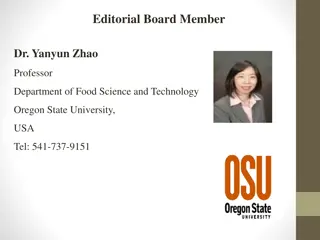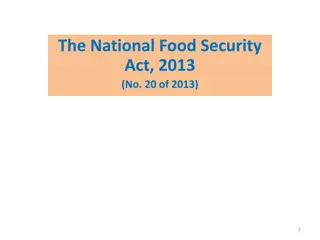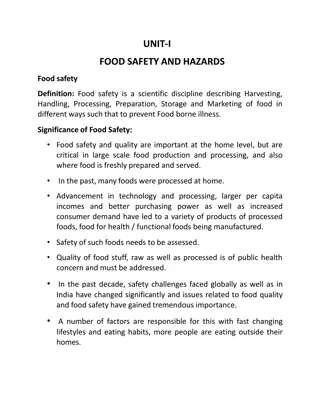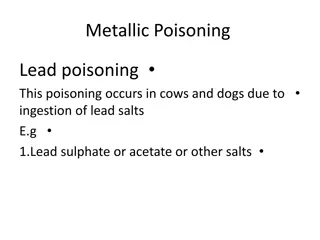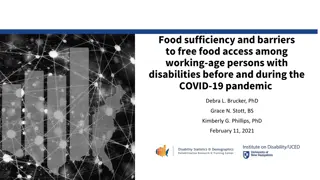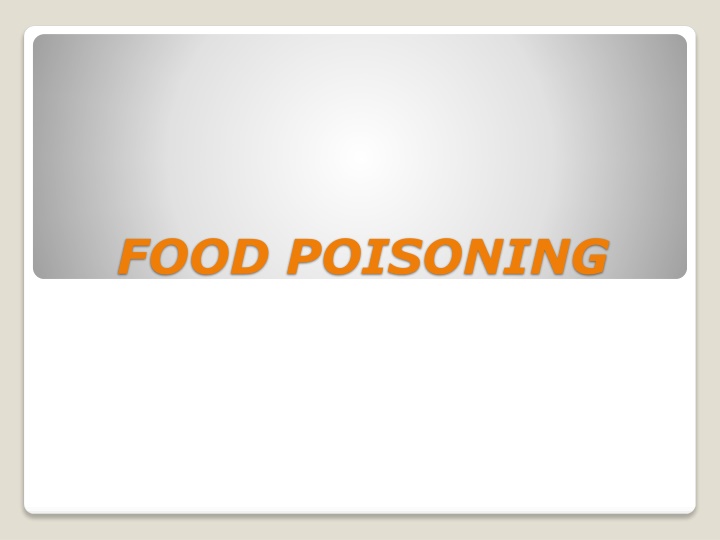
Food Poisoning: Causes, Types, and Prevention
Learn about food poisoning, an illness caused by consuming contaminated food or drink. Discover the different types, causes, and prevention methods. From bacterial to toxic types, find out how improper storage, inadequate cooking, and other factors can lead to foodborne illnesses. Explore the pathogens, incubation periods, and pathogenesis of food poisoning to protect yourself and others from falling victim to this common health issue.
Download Presentation

Please find below an Image/Link to download the presentation.
The content on the website is provided AS IS for your information and personal use only. It may not be sold, licensed, or shared on other websites without obtaining consent from the author. If you encounter any issues during the download, it is possible that the publisher has removed the file from their server.
You are allowed to download the files provided on this website for personal or commercial use, subject to the condition that they are used lawfully. All files are the property of their respective owners.
The content on the website is provided AS IS for your information and personal use only. It may not be sold, licensed, or shared on other websites without obtaining consent from the author.
E N D
Presentation Transcript
INTRODUCTION Food poisoning is referred to an illness acquired through consumption of food or drink contaminated with microorganisms or their toxins. The term bacterial food poisoning is restricted to acute gastroenteritis due to the presence of bacteria or their toxins in food. It usually results in an outbreak after consumption of food from a common source. Sometimes food poisoning may be due to non-bacterial causes such as chemical poison and poisonous mushrooms.
CLASSIFICATION Food poisoning can be classified into: i. Infective type ii. Toxic type iii. Intermediate type 1. Infective type Infective doses of microorganisms are ingested with food. Multiplication of bacteria occurs in-vivo. The typical example is food poisoning by non-typhoidal salmonellae. Incubation period is generally 8-24 hours.
2. TOXIC TYPE Preformed bacterial toxin is ingested with food, as in staphylococcal food poisoning. Incubation period is short (1 to 6 hours). 2. INTERMEDIATE TYPE Bacteria ingested with food release the toxin in the gut. The typical example is Clostridium perfringens food poisoning. The incubation period is 6 to 12 hours.
PREDISPOSING FACTORS 1. Improper storage 2. Inadequate cooking 3. Eating raw vegetables and food 4. Food cooked by carriers or infected persons ETIOLOGY Causative agents of food poisoning are shown in Table
TYPE INCUBATION PERIOD CAUSATIVE AGENT 1.Infective type 8 to 24 hours Non-typhoidal salmonella (S. Typhimurium, S. Enteritidis, S. Newport, S. Thompson, S. Indiana) Vibrio parahaemolyticus Campylobacter jejuni 2.Toxic type 1 to 6 hours Staphylococcus aureus Bacillus cereus (emetic type) Clostridium botulinum 3.Intermediate type 6 to 12 hours Clostridium perfringens Bacillus cereus (diarrhoeal type)
PATHOGENESIS Sources of infection includes different type of foods which may be vegetables, salads, poultry, eggs, fish, meat, sea food, fried rice, raw milk, milk products, cereals, canned food etc. The infection occurs by consumption of food which is contaminated with bacteria or their toxins. The pathogenic mechanisms include: 1. Invasion of gastrointestinal tract with bacteria e.g. Non-typhoidal Salmonella, Vibrio parahaemolyticus and Compylobacter jejuni.
These are infective type. These bacteria include diarrhoea. 2. Ingestion of preformed toxin in foods e.g. Staphylococcus aureus and Bacillus cereus which form toxins in food even before consumption. Such food induces vomiting and diarrhoea. These are toxic type. 3.ingestion of bacteria in food but toxin production occurs in gut after ingestion e.g. Clostridium perfringens which includes diarrhoea.
CAUSATIVE AGENT SOURCE OF INFECTION 1.Non-typhoidal salmonella Milk, eggs, poultry, meat 2.Vibrio parahaemolyticus Seafood 3.Compylobacter jejuni Raw milk, poultry, contaminated water Milk, milk products, cream, meat Fried rice from Chinese restaurants, vegetables, meat, cereals Canned food 4.Staphylococcus aureus 5.Bacillus cereus 6.Clostridium botulinum 7.Clostridium perfringens Meat,poultry Causative agents and their source of infection
CLINICAL FEATURES The incubation period varies according to type of food poisoning (1 to 24 hours) as mentioned earlier. Food poisoning is characterised by: Nausea and vomiting Diarrhoea Abdominal cramps Fever Bacillus cereus food poisoning may present as toxic type or intermediate type. Vomiting is rarely present in Clostridium perfringens and Bacillus cereus intermediate type infections but abdominal cramps may be present. Diarrhoea may be characteristic of all types of food poisoning.
LABORATORY DIAGNOSIS A. DETAILED HISTORY Detailed history of food consumed and sequence of occurrence of clinical symptoms with their duration should be taken. Number of persons affected by food poisoning is also important. These all would give clue to the etiological agent. B. COLLECTION OF SPECIMEN The following specimens may be collected. Stool Suspected food specimen In case of death, intestinal contents, liver, spleen and heart blood may be collected. Vomitus is less useful.
C. CULTURE Demonstration of causative agent can be done in stool specimen and the food consumed. According to suspected causative agent, culture of stool is done on blood agar, MacConkey agar and selective media. These culture media are incubated at 37 C for 24 to 48 hours. Selective media are used for B. cereus, Campylobacter jejuni and Vibrio parahaemolyticus. Selective media such as MYPA (mannitol egg yolk, polymyxin B, phenol red and agar) is used for B. cereus. Clostridium perfringens and Cl. Botulinum are cultured under anaerobic condition.
D. IDENTIFICATION Identification of causative agent is based on colony morphology on culture media, Gram staining, biochemical tests and other tests. E. DETECTION OF ENTEROTOXIN Enterotoxin in faeces can be detected by ELISA or latex agglutination test. F. MOLECULAR METHOD Polymerase chain reaction (PCR) can be used for detection of genes coding for enterotoxins. G. CARRIER DETECTION Repeated culture of stool and other specimens from suspected carrier is useful to trace the source of infection.
PROPHYLAXIS To prevent the occurance of food poisoning the only method is to be strict in cleanliness at all levels of preparation, storage and serving of food.
Textbook of Microbiology by Ananthanarayan and Paniker s. Textbook of Microbiology by D. R. Arora and Brij Bala Arora. Textbook of Microbiology by Dr. C. P. Baveja. REFERENCE BOOKS

